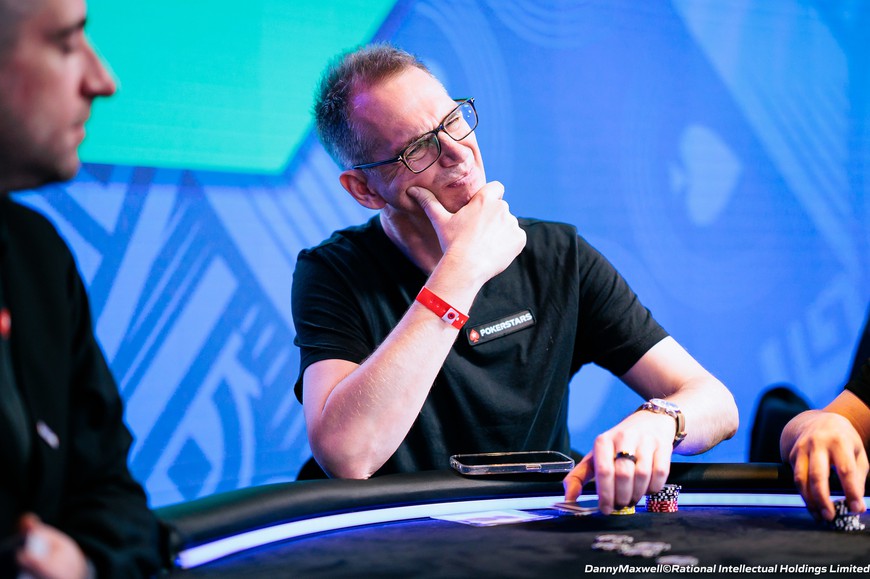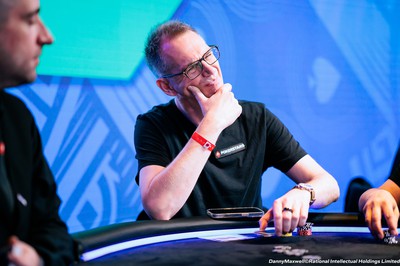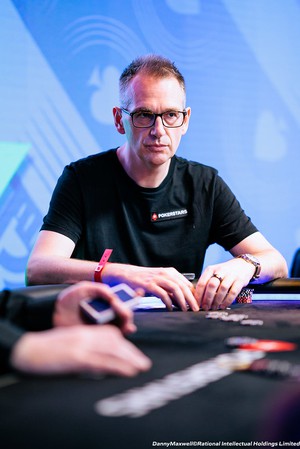

I still stand firm that even though we pitch the live streams primarily to poker fans, people who are already familiar with the game, that it should still be entertainment first and education second.
Poker has changed a lot in the last two decades, and so has James Hartigan.
British journalist James Hartigan, who started his career in radio and as a film critic, said he was introduced to poker during his last year at sixth form school in the UK — where he and his classmates would play seven-card stud. Hartigan said he occasionally played poker at college in the late 90s, and it was there that he got the idea of having a TV show where people would be playing poker.
According to Hartigan, at that stage in his life he was a “radio presenter who liked poker.”
Things changed quickly. Hartigan accepted an invitation from PokerStars to play in the inaugural season of the European Poker Tour (EPT), held back in 2004. He continued working with PokerStars, and by 2005 began hosting TV shows of live poker events for several media outlets, including ESPN in the US, and Channel 4 and Sky Sports in the UK.
That invitation to play in the first EPT turned into a 19-year career at PokerStars, according to LinkedIn. Hartigan currently serves as Brand Ambassador, Presenter & Commentator for the company.
Pokerfuse sat down with Hartigan on the sidelines of the 20th Anniversary of EPT Barcelona. We asked for his thoughts on the poker industry today, how poker commentary has changed over the years, and where commentary is going from here.
The following interview has been edited for brevity and clarity.
Mike: How has poker commentary evolved since the beginning?
James: Back in the day, if you were the play-by-play guy, if you were the lead commentator, it was literally “say what you see.” All you needed to know was that an ace was higher than a king and a flush beats a straight.
 But today, even though you rely very heavily on your analyst to get into the minds of the players, you need to know the right questions to ask. You yourself need to have enough of an understanding of the game to get by and even do a surface-level analysis.
But today, even though you rely very heavily on your analyst to get into the minds of the players, you need to know the right questions to ask. You yourself need to have enough of an understanding of the game to get by and even do a surface-level analysis.
I’ve been very lucky. I’ve worked with some of the greatest minds in poker and I’ve consumed enough poker content, both live and online, that my understanding of the game has gotten to the point where I can ask the right questions.
I’m not pretending that I’m an expert, but I saw a lot of the guys that were doing play-by-play in 2005, 2006 — they lost those gigs because they could not keep up with the audience. If the audience’s understanding of the game evolves, your understanding of the game has to evolve.
Obviously, there are all the technical advances in the game as well. We’ve seen more and more live streaming, and I’m very proud of the fact that the EPT pioneered it and all the other tours learned from that.
When you talk about the technical advances, the YouTube app and the Twitch app, it’s a TV show for many people, so it should look like one. The fact that we have people whose background is not in poker — they’re in sports TV, they’re professional sports broadcast teams — that’s how we’re able to present poker. And I still love the fact that we are able to do it that way.
Mike: How has social media changed commentary for poker?
James: What changed is when it became a truly interactive experience. The very first live streams we did, we had an email account for people to send in their questions and comments. Fast forward five years, we’re using the hashtag on Twitter. With platforms like Twitch and YouTube where you have a live chat, you’ve got instant interaction.
Having that ability to interact and answer questions, or to even run competitions in real time, that’s a very important aspect. To me, that separates doing it live from doing a TV show, where it’s basically a one-way street.
If the audience’s understanding of the game evolves, your understanding of the game has to evolve.
Mike: How would you say the online game has impacted what you do today for commentary?
James: Obviously, you see a lot of players who play both (live and online). A mea culpa on my part was maybe not knowing some of the players who were really hot online talents who were crushing all the high stakes tournaments on PokerStars, but when they would come to an EPT event, maybe I would not recognize them by name or by face — or if you told me their online handle, I would not be familiar with their resume.
That changed when live poker disappeared a couple of years ago, and we suddenly found ourselves covering every single SCOOP, every single WCOOP. EPT moved online for a couple of years. There was an online series every week because there was no live poker — and we started to see these guys playing the super high rollers.
I respect the fact that [online stars] earn all their money and learned their pedigree online, and now they’re crushing the live world as well. To me, understanding these players, who are really crushing it online, and respecting them in the live world, is very important.
Mike: What kind of innovation would you like to see in poker commentary?
James: What I like is the fact that we’re able to do the job twice — doing the live stream, and then re-voicing it again for TV shows. I know that sounds absurd, but the more data you can gather and the more understanding you have on the audience, the more you can tailor it for the people who are watching.
I still stand firm that even though we pitch the live streams primarily to poker fans, people who are already familiar with the game, that it should still be entertainment first and education second.
I think Power Path was a great innovation. I don’t think any of us knew that it was going to bring in all these first timers again
I love the fact that we get quite deep analysis from Griffen Benger and Nick Walsh, and from guest commentators like Sam Grafton, but number one, it’s primarily an entertainment stream. People can learn, and we understand that it’s a poker-educated audience, but we’re not going to bombard people with stats and graphics and charts.
When it comes to TV, you’ve got to dial that down even more. It’s pure entertainment. Yes, you want them to learn something, you want to understand them to understand it’s a strategy game. But more than anything, you’re also just trying to entertain and appeal to the mainstream crowd, so being able to tailor your product to a different audience is really key.
Mike: Are there any other observations that you would like to share?
James: I’m really pleased that we’re getting back to the days of the poker boom and the Moneymaker era, where we’re seeing more and more qualifiers coming in now. I think Power Path was a great innovation. I don’t think any of us knew that it was going to bring in all these first timers again — it was very clear that the traditional satellites were starting to get sharked a little bit and your average online qualifier was actually someone who’s already won several EPT events. But now I am genuinely seeing people living that dream again.
That’s such an important narrative. Poker’s biggest strength is anyone and everyone can play at the same table, and as a content maker that “David versus Goliath” battle is so important. It’s the thing I like to focus on, and those are the storylines that I like to follow.
I know the audience loves watching all the super high rollers, but I much prefer it when we get to a Main Event and I get to see the Steve O’Dwyers of this world compete against complete unknowns who are just having the time of their life on this amazing poker holiday and they get this amazing experience.
Obviously, you hope they cash — you want them to make it to the final table. You hope they win occasionally. But even if they’re just here, that’s huge.

